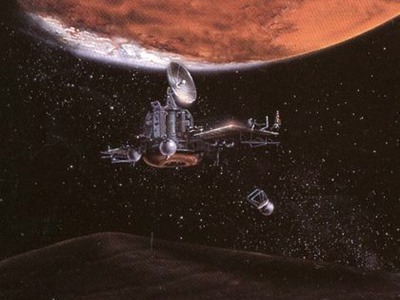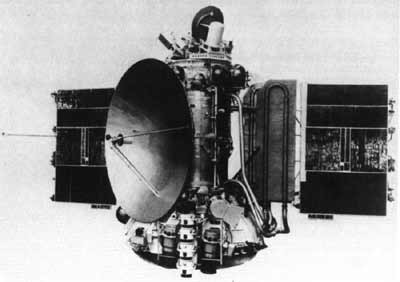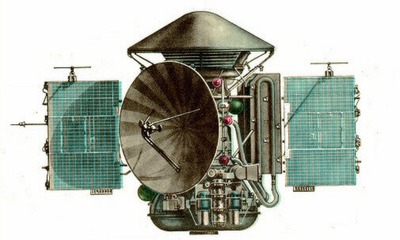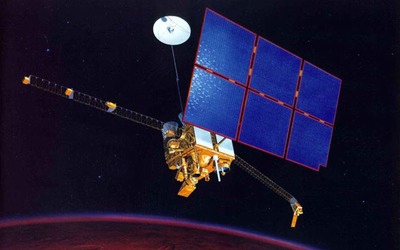Planetary orbit insertion failures (part 2)by Andrew J. LePage
|
| Although there are many possible causes, the consensus seems to be that Mars Observer was lost as a result of a fatal failure of the propulsion system. |
After years of delays, cost overruns, and a switch from the Space Shuttle to a Commercial Titan III/TOS for launch as a result of the 1986 Challenger disaster, Mars Observer finally lifted off on September 25, 1992, and was sent on its way to Mars. In order to avoid issues encountered with the propulsion system on the Viking spacecraft during their transit to Mars, the decision had been made seven months before launch to postpone the pressurization of the propellant tanks that fed a redundant pair of 490-newton (110-pound-force) bipropellant engines to be used for major maneuvers, including the vital 28-minute, 50-second orbit insertion burn. Minor course corrections took place during the cruise to Mars in a “blow down” mode that did not require full pressurization of the system.
On August 22, 1993, with just 68 hours to go before orbit insertion, the propulsion system was finally pressurized. Because of concerns about the effect the mechanical shock caused by detonating the pyrotechnics used to open the valves would have on the radio electronics in a powered state, the decision was made to shut down Mars Observer’s transmitter during this vital operation. Unfortunately, Mars Observer was not heard from on schedule 14 minutes after pressurization, and all attempts to regain communications failed.
Investigators never determined a definitive cause for the loss of Mars Observer because of a lack of telemetry during the pressurization of the propulsion system. Although there are many possible causes, the consensus seems to be that Mars Observer was lost as a result of a fatal failure of the propulsion system which, since it was borrowed from an Earth-orbiting satellite, was never designed to delay pressurization after months in space. The best guess is that a small amount of nitrogen tetroxide oxidizer leaked past a valve during the long cruise to Mars and came into contact with the hydrazine fuel during pressurization, causing a failure of the system’s plumbing. Mars Observer would have gone into an unrecoverable tumble as a result of venting propellants from broken pipes. This loss—which showed the weakness of the philosophy of adapting Earth-orbiting spacecraft to planetary missions—along with Mars Observer cost overruns essentially killed the Planetary Observer program and set the stage for the “faster, better, cheaper” Discovery program (which has had its own problems, as we have seen already.)
 An artist depiction of Phobos 1 above the Martian moon. (credit: NASA) |
Phobos 1
After a hiatus of 15 years of Soviet missions to Mars (and 13 years after the launch of the American Viking missions), the Soviet Union launched Phobos 1 on July 7, 1988, on a Proton-D launch vehicle. Along with its sister craft, Phobos 2 launched on July 12, these spacecraft were the first of a totally new, third-generation interplanetary spacecraft replacing the highly successful Venera design that had been used for a decade to explore Venus and adapted as part of the Soviet Vega mission to Venus and Comet Halley (See “A chance of a lifetime: the missions to Comet Halley”, The Space Review, March 14, 2011).
The mission of this pair of spacecraft was to rendezvous with the small inner moon of Mars, Phobos, and study it at ranges as close as 50 meters (165 feet) with a suite of state-of-the-art instruments. Building on the experience of international cooperation fostered during the earlier Vega missions, the Phobos mission featured cooperation from 14 other nations providing instruments and expertise, with the US contributing use of its Deep Space Network. Included on both spacecraft was a small stationary lander that would be deposited on the surface during a low flyby of the moon. Phobos 2 also carried a small mobile “hopper” that would take advantage of the low-gravity environment of this moon to hop from one location to the next, making in situ measurements along the way.
| There was even odds that any given spacecraft in the Mars armada would succumb to a failure of a vital system before reaching its target. |
But as had happened far too often in the past, the first flights of a new Soviet planetary spacecraft design inevitably uncovered problems that led to mission failure. On August 29, 1988, a software upload was transmitted to Phobos 1 but a single character error, coupled with the lack of appropriate safeguards in the flight operating system, inadvertently resulted in the spacecraft’s attitude control system being deactivated—something that would only be done during ground testing. Unable to keep its solar panels oriented towards the Sun, the batteries on Phobos 1 drained, resulting in the loss of the spacecraft. The error was not discovered until nothing was heard from the spacecraft during a scheduled communications session on September 2. Attempts to regain contact with Phobos 1 continued until the mission was declared a loss on November 3, less than three months before it was to enter orbit around Mars.
Phobos 2 fared better, successfully entering orbit around Mars on January 21, 1989. Although orbit insertion was successful, ground controllers had discovered that one of the three processors in the flight control system had failed with another showing signs of trouble. While the mission continued in preparation for a scheduled April 7 rendezvous with Phobos, control of the spacecraft was lost during a session to observe the Martian moon on March 27 and was never regained. While it was not known at the time, these would be the last Soviet planetary missions before the dissolution of the USSR in 1991.
 Photo of Mars 4 before its launch to Mars. (credit: NASA) |
Mars 4
The United States and Japan have not been the only nations to experience problems entering orbit around Mars. The very first planetary orbit insertion failure involved a Soviet spacecraft. Mars 4 was the first of an armada of four spacecraft launched by the Soviet Union towards Mars in 1973 as a last-ditch attempt to land on Mars before the upcoming Viking mission set for launch in 1975. This group of spacecraft, which consisted of pair of orbiters, Mars 4 and 5, as well as a pair of lander-laden flyby craft, Mars 6 and 7, was the second attempt by the Soviet Union to reach Mars using a new generation of advanced spacecraft employing the powerful Proton-D launch vehicle.
During the late stages of assembly and test of this quartet of spacecraft, engineers discovered that a key transistor used in systems throughout the ships, designated 2T-312, had not been manufactured to the established requirements. Someone had decided to cut corners and use cheaper aluminum leads instead of gold as had been specified and without the performing the appropriate tests to determine that the change would work. As a result, they found that the time-to-failure for this vital component had been cut significantly due to corrosion of the leads, and thus there was even odds that any given spacecraft in the Mars armada would succumb to a failure of a vital system before reaching its target.
With no time to replace the faulty components before launch, the decision was made to launch all four spacecraft and hope for the best. Mars 4 was launched on July 21, 1973, with its sister orbiter, Mars 5, following on July 25. Mars 6 and 7, carrying their landers, launched on August 5 and 9, respectively. As had been feared, the failure of the 2T-312 transistors affected all four spacecraft to some degree or another. In the case of Mars 4, two of the three channels of the main computer, including, unfortunately, the channel that controlled the main KTDU-425A engine, failed after the first course correction. This meant that Mars 4 could no longer use its propulsion system to make course corrections or enter orbit around Mars. Mars 4 flew within about 2,200 kilometers (1,400 miles) of Mars on February 11, 1974. While it was reprogrammed to acquire a swath of images and make other observations during its brief encounter with the Red Planet, its mission was largely unsuccessful and resulted in the first planetary orbit insertion failure.
 Artist concept of Mars 3. (credit: IKI) |
The near-failure of Mars 3
The spacecraft that probably came the closest to failing to enter orbit around its target but actually made it nonetheless was the immediate predecessor of Mars 4. Mars 3 was the third of a trio of Soviet spacecraft launched towards the Red Planet during the 1971 window. Because this launch window was so much more favorable than the one in 1973, Mars 2 and 3 could be launched with a lander and over a ton of propellant to enter orbit around Mars after their landers had been deployed. However, because the ephemeris for Mars available to Soviet scientists at the time was so inaccurate, Mars 2 and 3 were to be preceded by another spacecraft carrying double the propellant load but no lander. This spacecraft would follow a faster trajectory to Mars and enter orbit several weeks ahead of its lander-laden sisters. The tracking information obtained while this spacecraft was in orbit would provide a vitally needed update of the position of Mars to ensure the success of the landers to follow. Unfortunately, a programming error in the timer of the craft’s navigation system stranded the spacecraft and its Blok D escape stage in Earth orbit after its launch on May 10, 1971, to become Kosmos 419.
| Mars 3 accurately placed itself into position to enter a planned orbit with a period of 25 hours. Instead it was found Mars 3 ended up in an extended orbit with a period of almost 13 days! |
Without the required navigation information, Mars 2 and 3, launched on May 19 and 28, 1971, respectively, would have to rely on their highly advanced but untested autonomous navigation system. Originally meant to be used as a backup to direct commands from ground controllers, the new navigation system of the second-generation Soviet planetary probes was designed to determine the position of its target using onboard sensors, automatically make any required last-minute course changes, accurately deploy its lander, and enter the desired orbit all on its own. This advanced navigation system was successfully used by Mars 6 in 1974 when the failure of a 2T-312 transistor resulted in a transmitter failure preventing it from being tracked. Mars 6 automatically made all the required course corrections and successfully deployed its lander that, unfortunately, failed upon touchdown.
When Mars 3 reached its target on December 2, 1971, it used its automated navigation system to make a last minute course correction and successfully deploy its lander, which fell silent only seconds after beginning its transmissions from the Martian surface. Meanwhile, Mars 3 accurately placed itself into position to enter a planned 1,500-by-33,000-kilometer (930-by-20,500-mile) orbit with a period of 25 hours. Instead it was found Mars 3 ended up in an extended 1,530-by-190,000-kilometer (951-by-118,000-mile) orbit with an orbital period of almost 13 days! Travelling at a speed of 4,120 meters per second (9,220 miles per hour) at periapsis, Mars 3 was moving just 50 meters per second (120 miles per hour) shy of escape velocity.
Sources seem to indicate that the near-failure of Mars 3 boiled down to inadequately tested software used by the autonomous navigation system. Apparently, if the velocity of the spacecraft was changing quickly (as would happen during a full-thrust orbit insertion burn), the control system could miscalculate the total change in spacecraft velocity based on data from onboard sensors, resulting in the engine shutting down at the wrong time. In the case of Mars 3, the KTDU-425 engine had cut out about 26 seconds too early into its required three-minute orbit insertion burn. If the orbit insertion burn had been about 7 seconds shorter still, Mars 3 would have failed to enter Martian orbit and would have had the distinction of being the first planetary orbit insertion failure. Fortunately, Soviet engineers learned from the experience and upgraded the autonomous navigation system. Along with other improvements made after the problems encountered with Mars 2 and the failure of the 1973 missions to Mars, this spacecraft design was eventually used in the highly successful Venera missions of the 1970s and 1980s.
General References
Brian Harvey, Russian Planetary Exploration: History, Development, Legacy and Prospects, Springer-Praxis, 2007
Andrew J. LePage, “The Mars Orbiter That Almost Was Not”, Drew Ex Machina, May 22, 2014
Masato Nakamura et al., “Return to Venus of the Japanese Venus Climate Orbiter Akatsuki”, Acta Astronautica, Vol. 93, pp. 384–389, January 2014
V.G. Perminov, The Difficult Road to Mars: A Brief History of Mars Exploration in the Soviet Union, Monographs in Aerospace History No. 15, NASA, July 1999
Paolo Ulivi with David M. Harland, Robotic Exploration of the Solar System Part 2: Hiatus and Renewal 1983–1996, Springer-Praxis, 2009
Paolo Ulivi with David M. Harland, Robotic Exploration of the Solar System Part 3: Wows and Woes 1997–2003, Springer-Praxis, 2012
Mars Climate Orbiter Arrival Press Kit, NASA Press Release, September 1999
